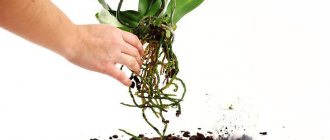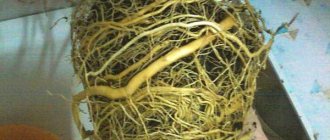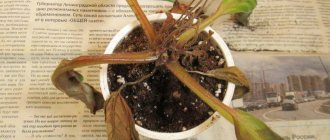What to do if there is a need to replant a flower not in the spring?
If you understand that without replanting the plant will die (for example, because the roots are rotting or pests have appeared in the soil that you cannot control with the help of special chemicals), the plant can be replanted at another time of the year. In the spring, as stated, plants tolerate transplantation best and, moreover, need it at this time. However, in summer, autumn, and winter they are able to take root in a new flowerpot. When transplanting in winter, the risk of losing the plant is maximum; flowers transplanted in summer and autumn usually survive.
What plants can be handled
A number of indoor species do not tolerate regular transplantation, after which they take a long time to recover or die. There is no need to talk about their decorativeness. Also, replanting using this method is suitable for fast-growing indoor specimens.
Therefore, such indoor species as cycas, nolina, cypress, palm trees, dracaena, yucca, adiantum, fatsia and other species are transplanted using the transshipment method.
How often should a plant be replanted into another pot?
It is not worth replanting the plant into another pot more than twice a year. Even this frequency is considered frequent, so the flower is replanted more often than once a year only in cases of expressed need. Otherwise, everything depends on the type and age of the plant. Young plants are usually transplanted into a new pot annually, adults - once every 3 years, sometimes even less often.
Transshipment of plants
The difference between the transshipment procedure and transplantation is that the earthen lump in the first case is not violated. During this procedure, the volume of soil needs to be increased, so a slightly larger (several centimeters) diameter pot is used.
Most beautifully flowering plants require multiple transfers when propagated by seeds. Cyclamen and gloxinia require two transfers during the period from sowing to the beginning of flowering; hybrid cyceration requires three.
After the procedure, the growth process does not slow down, so you can get strong and well-developed specimens.
- Author: Maria Sukhorukikh
Rate this article:
- 5
- 4
- 3
- 2
- 1
(0 votes, average: 0 out of 5)
Share with your friends!
Does the size of the pot matter?
Both the size and shape of the plant pot are important. The new pot into which the flower is going to be transplanted should be approximately 2 cm larger in diameter and higher than the one from which the plant is transplanted. In this case, he will be comfortable in his new place of residence for a long time.
The preferred form depends on the type of plant and the location of its root system. Succulents and cacti need a wide and shallow pot, flowers with a developed root system need a deeper one.
Regardless of the type of plant, the pot should be narrower at the bottom than at the top, otherwise it will be problematic to transplant the plant from it into another pot.
Sequence of actions during transshipment
First you need to prepare a place for landing. More than once, in recommendations for transshipment, I came across a different order of actions: first remove the plant from the pot, then prepare the place for planting. In my opinion, we need to do the opposite.
Houseplants
If you are moving a houseplant, prepare a new pot (container, flowerpot). In volume it should be slightly larger than the one in which the culture for transplantation is located. How much is this in centimeters: add 2 cm to the size of the diameter and height - this will be the approximate volume of the new container. That is, if you bought a seedling in a pot with a diameter of 10 cm and a height of 12 cm, then replant it in a pot with a diameter of 12 cm and a height of 14 cm. Of course, the value of 2 cm is quite arbitrary, if the size of the new container is 3 or 3.5 cm larger - it's not critical. But you shouldn’t transplant plants from small pots into very large ones right away. The soil, which is not entwined with roots, turns sour very quickly, which can lead to disease and death of the plant.
It is not worth replanting plants from small pots into very large ones at once.
But what about large indoor plants, since it is impossible to increase the volume of the planting container indefinitely? In this case, you will have to replace the soil minimally - remove a little from the top (manually, very carefully so as not to damage the roots). During the time that passes from replanting to replanting, the soil in the pot becomes compacted and its volume decreases. Therefore, when transshipping, it is always possible to pour a little fresh soil mixture at the bottom of the same container. Plus add a small layer on top - to replace what you removed by hand.
How often do indoor crops require transshipment? I stick to a recommendation I read in an old magazine on indoor floriculture:
- young, actively growing - annually;
- adults (large) or plants whose growth needs to be limited - once every 2-3 years.
Transplanting seedlings and seedlings into the ground
To transfer plants into the ground, the place also needs to be prepared in advance. For trees and shrubs - dig planting holes, make a drainage layer (if required), fill with compost, add fertilizer - depending on the requirements of the crop being planted. I pay special attention to preparing the site for planting coniferous crops - I always add special ready-made soil for them.
Drainage
In containers for indoor plants, the presence of a drainage layer (even minimal) is a prerequisite. What can be used as drainage: small expanded clay granules, crushed stone, pebbles.
What can be used as drainage: small expanded clay granules, crushed stone, pebbles
I have read many times recommendations to use polystyrene foam broken into small pieces for the drainage layer. At first glance, this is useful advice: the foam is lightweight (which is especially important when handling large plants - the weight of the plant itself, the pot and the soil is enough; you don’t want to add the weight of pebbles or crushed stone). But in practice, the recommendation turned out to be harmful. The roots of the plant easily grew through the foam granules; it was impossible to remove them without damaging the roots, so I had to carefully trim them. That is, the basic principle of transshipment—preserving the integrity of the root system—was not observed.
Addition of soil
The drainage layer should be covered with soil. How thick should it be? Again, we look at the specific situation, taking into account the difference in the size of the old and new containers.
Do I need to prepare the pot?
Any pot must be thoroughly washed and dried. It is especially important to thoroughly wet and dry porous clay pots.
Also, it would not hurt to treat the pot with a solution of potassium permanganate to protect the plant from possible diseases and pests. It is especially important not to neglect this procedure if another plant was already growing in the pot before.
If the pot is new, it may not have drainage holes. This drawback should be eliminated yourself by screwing the holes with a drill or an ordinary drill or awl. You can punch holes with a nail, but in this case there is a danger that the plastic will crack and the pot will split.
Errors and their consequences
The main ones:
Poor quality water
Using cold water straight from the tap is not suitable for flowers due to the large amount of harmful impurities, especially chlorine, so it should be left for 24 hours in a warm place.
If you know that tap water in a region has high hardness, it is useful to soften it by adding peat, wood ash, citric acid, or passing it through a water purification filter.
Due to watering with low-quality water, a white coating forms on the ground, the leaves turn yellow and fall off, chlorosis develops - a disruption in the production of chlorophyll, and the plant may die.
Water jet
Watering cans must have dispersive nozzles so that the water stream does not hit the ground with force and does not erode the soil, exposing the roots of flowers, but evenly moistens the surface around the perimeter without the formation of holes and puddles.
Sometimes when watering flowers from above into the ground, light, overdried soil does not retain moisture well, and some of it accumulates in the tray.
Do not think that the flower is over-watered and immediately remove the water from the pan. It is better to wait 1 hour, during which time the earth will absorb the required amount of water, and only then drain the excess.
Single watering for all flowers
It is advisable to separate moisture-loving and drought-resistant plants indoors into different groups when watering , and plant them in different flower beds and flower beds in the garden to take into account their individual needs. Otherwise, some plants will be sufficiently moistened, while others will be overwatered or overdried.
Mistakes when watering plants - in the video:
What else, besides a new pot, is needed to replant a plant?
To transplant a plant into another pot, you will definitely need drainage (it can be replaced by shards, polystyrene foam) and soil. Without drainage, the roots of the flower will quickly rot and it will die. If the old soil is not replaced with new soil, replanting loses its meaning altogether. The composition of the soil must correspond to the needs of the plant (violets need one, cacti need a completely different one).
In addition, tools (knife, pruning shears) may be required. When replanting cacti or poisonous plants, be sure to protect your hands with gloves. However, they will not interfere in any case.
Signs of a necessary transplant
You can often tell that your plant needs replanting by its appearance:
- there is no growth of shoots;
- leaves turn yellow;
- flowers develop poorly;
- the earthen lump of the plant protrudes from the pot;
- earthworms appear in the soil;
- The flowering period is shortened.
The absence of external signs does not always mean that a transplant is not required. Remove the earthen lump from the bowl and inspect: if it is heavily entwined with roots, the plant has become cramped in the pot. To remove the earthen lump, you need to water the plant, then turn the pot upside down and hit the bottom with your palm.
Do I need to water the plant when transplanting?
The issue of watering flowers before and after transplantation is the most controversial among amateur flower growers. Some believe that the plant needs to be well watered just before replanting, and then not watered for a long time, others believe that watering is needed immediately after replanting, but the plant should not be watered before replanting. The optimal solution would be the following:
- Water the plant a few days before transplanting so that the soil is not too dry at the time of transplanting. If you water the flower immediately before transplanting, the heavy soil will tear its roots. If the soil is dry, then shaking it off the roots will almost inevitably damage them too.
- Replant the plant in slightly moist soil so that the roots can immediately receive nutrition from the soil.
- Start watering the transplanted flower a few days after transplantation, and watering should not be abundant. The fact is that young and injured roots quickly rot if over-moistened. Moreover, the more the plant is afraid of excessive moisture, the later it should be watered after transplantation. Start watering moisture-loving flowers in a day or two, otherwise they will begin to fade. Start watering cacti only after a week. On average, watering is resumed on the third day after transplantation.
To avoid making mistakes, check when it is advisable to start watering the plant you are replanting. This circumstance depends mainly on the type of indoor flower and on the state of its root system. It is logical that if you are replanting a flower because its roots have begun to rot, excessive moisture after replanting will be completely detrimental to it.
How to properly replant an indoor flower?
- Need to prepare the pot
Before transplanting a plant into it for permanent residence, it needs to be prepared. A new one can be disinfected simply by pouring boiling water over it, and the one that has already been used should be washed well with soap and then rinsed thoroughly. If there is plaque inside the pot, then lemon water will help get rid of it: use 0.5 tsp. for 3 liters of water.
Cooking the pot
Leave the pot in this solution for 1.5 hours, and the plaque will be easily washed off. Leave the clay pot in water overnight to get rid of burnt lime, which when combined with water forms compounds that are harmful to the roots.
- Extracting the plant
The day before the upcoming transplantation of an indoor flower, you need to water it generously or lower the pot with the plant into a container of water, so that the water reaches the edge of the pot, then it will be easy to remove it from the old container. The best way to remove it is to take the pot with one hand and tip it onto the palm of the other hand so that the stem of the plant is squeezed between your fingers and the pot is upside down. Gently knock on the bottom and walls of the pot so that the lump of earth comes out.
Extracting the plant
Then you need to carefully clean the roots of the plant from the top soil, trying not to damage them. Remove rotten roots. If the roots are damaged, sprinkle the cut with crushed coal. You cannot keep exposed roots in the air for a long time, because... small hairs may dry out and the plant will wither.
- Make drainage
The pot should have holes, and a 1-2 cm layer of pebbles or small expanded clay should be placed on the bottom. If your flowerpot does not have holes, then the drainage layer should be more than 3-4 cm.
- Landing
Fill the pot with soil and lower the plant onto a layer of soil so that the root collar is just below the edges of the pot. There should be no free space between the roots, so the soil must be compacted. The root neck of the flower should be located flush with the ground, which, in turn, should be 1-2 cm below the edge of the pot.
Fill the gaps between the remaining old lump of earth and the walls of the pot with a new moistened substrate. The water temperature to moisten the soil should be a couple of degrees higher than room temperature. Expanded clay should be poured onto the top layer - it will protect the soil from mold and also give a more original look.
Flower transplant
When replanting indoor flowers, it is not recommended to trim the plants, as it will be difficult for them to recover from two stresses. And most importantly, it is best to replant flowers during the waxing moon, then they will take root better and will endure the “housewarming” painlessly.
Do I need to fertilize flowers when transplanting?
You may find fertilizers in the store that say they help the growth of the root system when replanting plants. But this does not mean that they can feed the flower immediately after transplantation. When transplanting flowers, you cannot fertilize them! After this point, at least two weeks, and preferably even three, should pass before the first portion of fertilizer is introduced. After this, in spring and summer, indoor plants are fertilized 2 times a month, during the dormant period - once a month or even less often.
Why is transshipment necessary?
In the garden, vegetable garden and flower beds (and whoever has indoor plants, even in the room) we constantly replant something. Fruit and ornamental trees and shrubs, flowers, seedlings.
The transshipment method is used to replant plants only with a closed root system.
If we (or seedling sellers) dig up plants from open ground, we damage their roots (to a greater or lesser extent). Naturally, it will take them time to recover from the transplant. All the plant’s forces during this period will be directed to restoring the root system, growth will stop, and resistance to diseases will be reduced. By transshipping plants with ZKS, we preserve their root system as much as possible, which is why the method is called “gentle” transplantation.
Choose the right soil
Probably the most important stage of replanting a plant is selecting the optimal soil for it. It is the characteristics of the soil that largely determine how the plant will tolerate the “move” and whether it will take root after it. Creating the right soil is complex and requires serious knowledge and experience in crop production. Therefore, in my opinion, it is best to follow the path of least resistance and buy a ready-made substrate of the desired type at a gardening store. This is much more convenient, since manufacturers usually indicate on their products which plants the soil is suitable for. Accordingly, you only need to know the name of the plant being transplanted.
Why do you need to replant indoor flowers?
Plants develop in the cramped space of a flower pot. The root system increases in size over time, the soil loses its beneficial properties, so house plants require replanting. In this case, the soil is replaced partially or completely. You can determine that there is a need for such an event when thin roots appear peeking out of the drainage holes of the flower pot. They signal that the roots are already cramped in the container.
In addition to replanting plants, which is carried out during a favorable dormant period for them, there are emergency cases that require out-of-hour replanting.
There may be different reasons for this:
- roots rot;
- the earth acquires an unpleasant odor;
- replacing a broken pot;
- you need to replant an imported specimen purchased growing in a peat pot.
If urgent measures are not taken, indoor flowers may develop poorly and even die.
The flower is crowded - we replant it
The diagnosis “urgently needs replanting” is given to plants in several other cases, and then this procedure has to be carried out, regardless of the time of year. For example, if the roots have filled the entire pot and protruded onto the surface of the earthen ball or are sticking out of the drainage hole, do not wait for spring, replant the flower, otherwise it will not have enough strength to survive the winter. To ensure that the plant endures this procedure as easily as possible, use the transshipment method.
Related article: Propagation of roses by cuttings from a bouquet and in potatoes, methods of cutting roses
In addition to this case, it is worth replanting the flower:
- if within a month after the onset of spring the plant does not produce new leaves and peduncles;
- if the soil dries out very quickly, that is, it is filled with roots;
- if you bought a flower in a store that was planted in a temporary peat substrate (the plant will not live long in such soil);
- if the pot bursts.
There are plants that are not even replanted every year. For example, palm trees, sheffleras, cacti, and adult orchids should not be disturbed so often. They can change their place of residence no more than once every two years.
When to replant flowers
Spring is a time of renewal, including for indoor plants. Over the winter, many of them depleted the soil in which they grew. With the beginning of spring, some not only did not produce new shoots, but also began to lose old leaves. If you see that the plant has not come to life in the spring, but, on the contrary, has frozen and is not growing, replant it.
Transplanting in the spring has an encouraging effect on most plants, so in late February or early March you can devote a day or two to replanting plants that need it.
Almost all plants can be replanted in spring, especially those that bloom in spring or summer.
Orchids: transplantation and care at home
One of the most capricious plants are orchids. Transplantation and care at home require special care.
Transplanting a phalaenopsis orchid at home is compared by many gardeners to a complex surgical operation.
Orchid transplantation should be done on time, as the substrate wears out. This should be done every 2-3 years. And under no circumstances during the orchid’s blooming period. If the time for replanting has come and the phalaenopsis is blooming, wait until all the flowers have fallen.
When purchasing phalaenopsis in a store, you need to check with the seller about the time of the next transplant.
Here are the basic rules for replanting orchids:
- Orchids are also best replanted in the spring. This will give the plant the opportunity to quickly adapt and establish roots in the new substrate.
- The substrate should be purchased at a specialized store, and it is better to further disinfect it.
- The pot should be transparent to provide sunlight access to the root system. Before planting, the container should be washed in the dishwasher, or a detergent should be applied for a quarter of an hour.
- When replanting an orchid, special attention should be paid to the roots. After removing the plant from the old pot, the root system should be washed and carefully inspected. Densely intertwined roots indicate the normal state of phalaenopsis.
- Before transplanting, the orchid should be placed in a basin with warm water and a small amount of potassium permanganate. After 20 minutes, the substrate and ingrown bark will become much easier to separate.
- Rotten or dried roots need to be trimmed. The knife must be treated with alcohol before cutting. Cutting areas must be disinfected with cinnamon or activated carbon.
- After this, the plant should be left alone, preferably overnight, but for at least 2-3 hours. This will give all wounds the opportunity to heal. The plant must be absolutely dry so that the process of decay does not begin.
- A small amount of disinfected drainage should be placed in a new container. The orchid should be planted clearly in the middle of the pot, removing all the roots, including new ones that have grown on top of the pot.
- The upper roots should not be heavily covered with substrate. A stem growing to the side should be supported or tied.
- If the orchid rested all night before planting, you can water it immediately after transplanting. It is better to do this in the shower, the water should be warm.
Before embarking on this complex operation, it is better to watch the process of transplanting an orchid on video to avoid disappointment and death of the plant.











